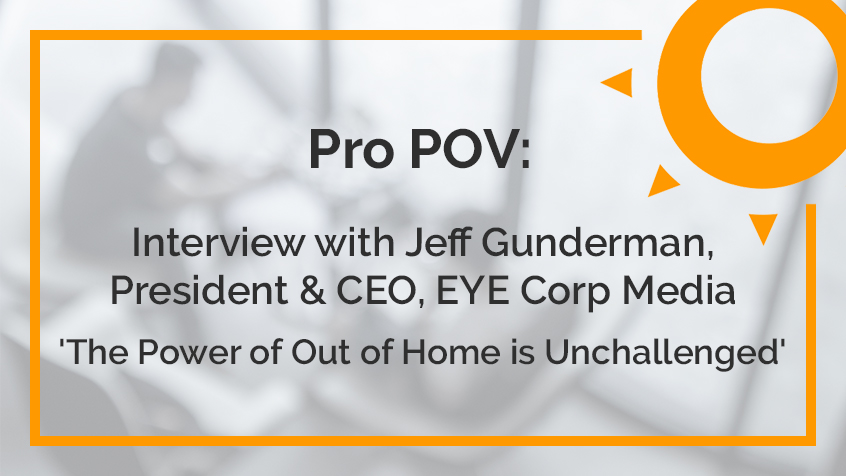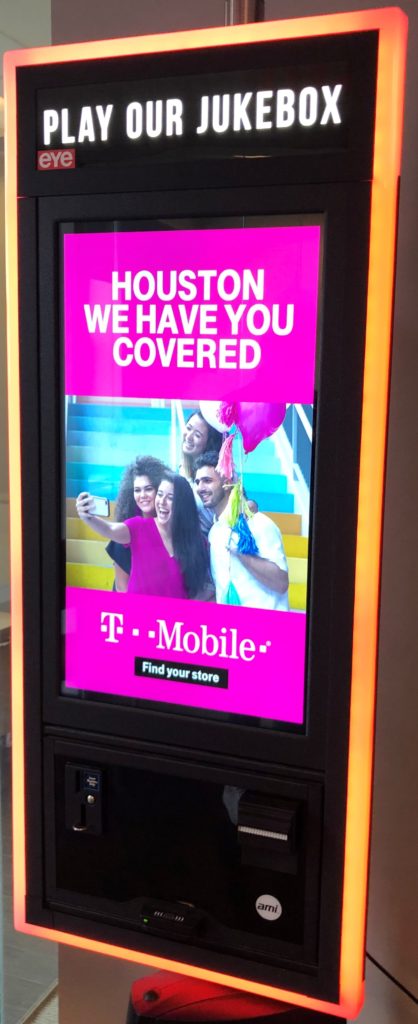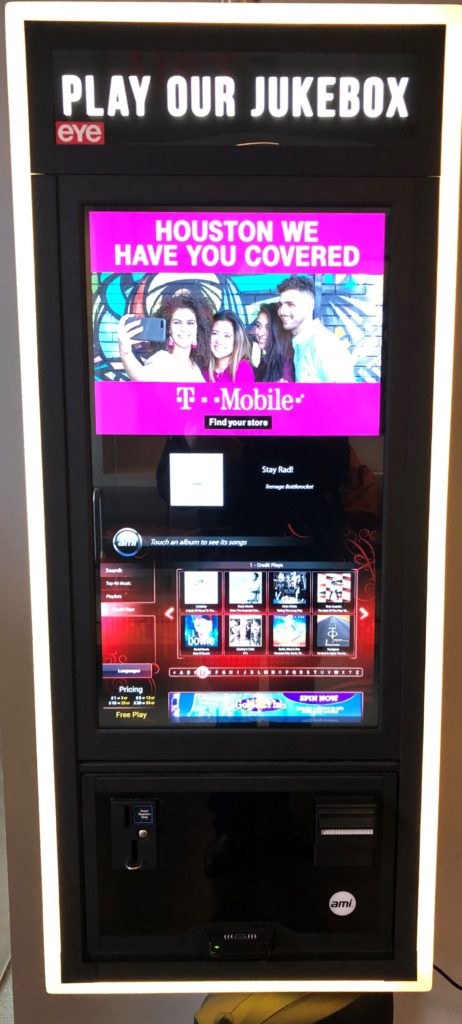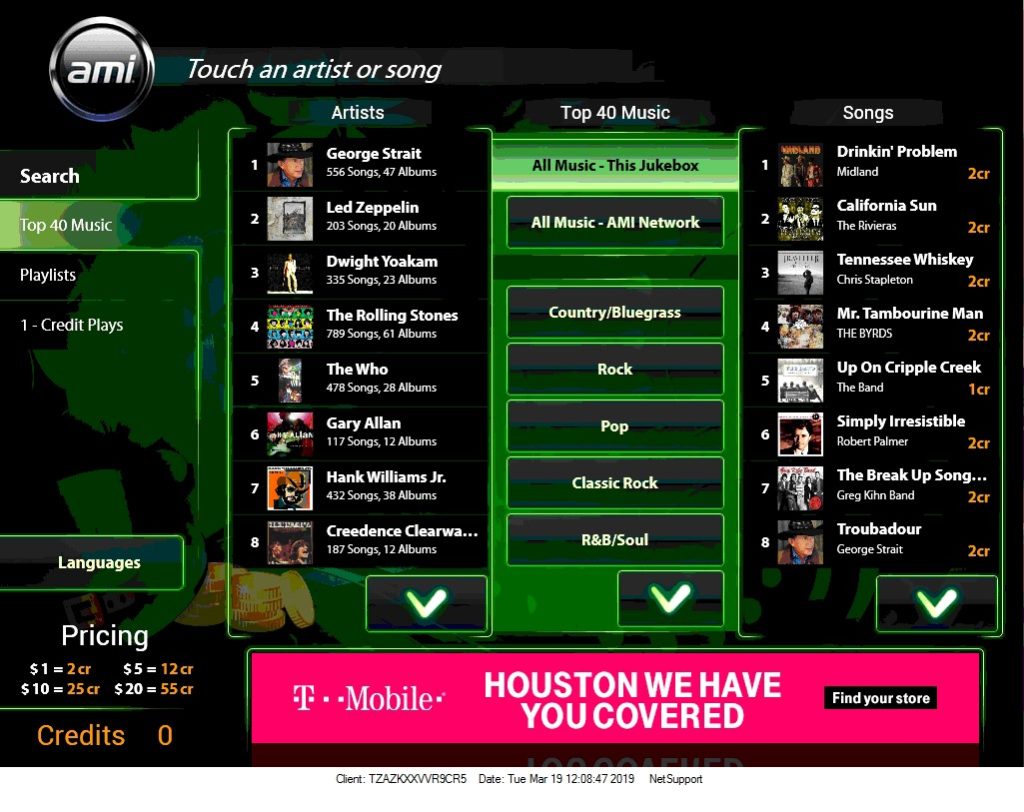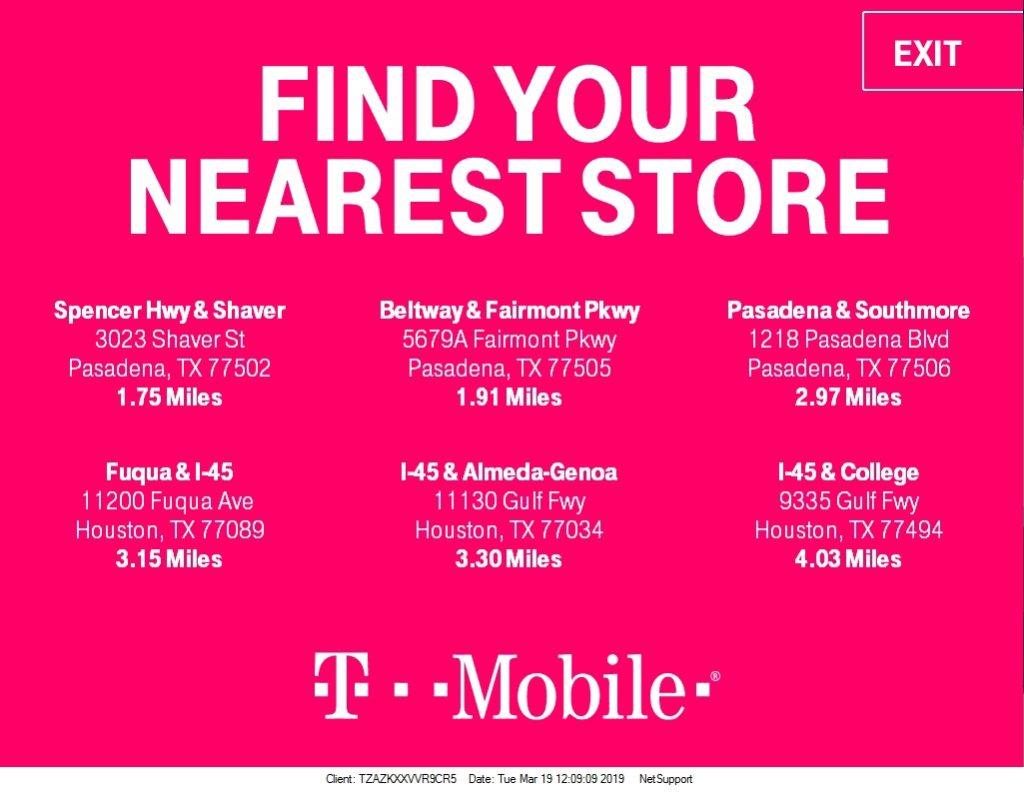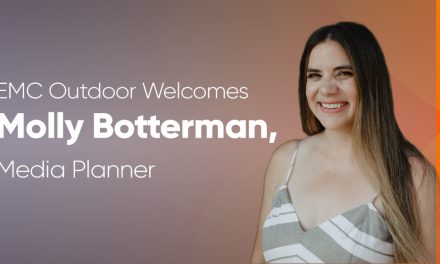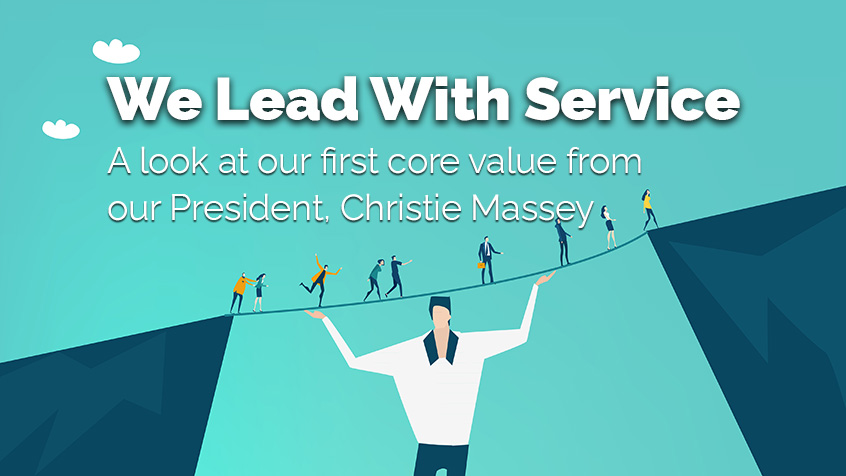Jeff Gunderman has been a prominent voice in advertising and marketing for decades. We decided to tap his extensive field and agency knowledge to help us understand the current state of out of home, success stories, and exciting growth opportunities!
. . . . .

For more than ten years, Jeff Gunderman has been responsible for leading EYE Corp Media, in the United States as President & CEO. Prior to EYE, Jeff spent more than 12 years at Eastman Kodak Co. including time running a marketing division, managing advertising agency relationships and buying media. Jeff’s time at Kodak also included time in product and sales management representing the Kodak film, ink, and printer materials used by printers to create out-of-home billboards, duratrans and other printed ads. He also spent time in online direct response media prior to joining the out of home industry in 2008.
Jeff is also very active in the media industry including serving on the board of both the Out of Home Advertising Association and Geopath and regularly contributes to thought leader committees, articles, and speaking opportunities.
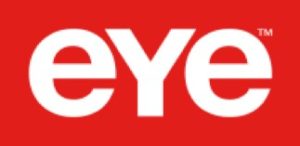 EYE Corp Media helps brands reach consumers where they shop, dine, commute and play. We effectively aggregate location-based digital networks into a single platform across bars and restaurants, cinema, retail, and transit to offer a large scale nationwide digital network of over 25,000 screens that is easy to plan and buy.
EYE Corp Media helps brands reach consumers where they shop, dine, commute and play. We effectively aggregate location-based digital networks into a single platform across bars and restaurants, cinema, retail, and transit to offer a large scale nationwide digital network of over 25,000 screens that is easy to plan and buy.
. . . . .
How has OOH managed to stay relevant for your clients, and even seen a resurgence?
I would use the word evolution, as opposed to resurgence. OOH media has enjoyed continued year-over-year growth so it simply keeps getting stronger. That said, the last 10 years have seen a massive evolution with the deployment of digital screens, mobile integration and advances in measurement. OOH media can’t be turned off, tuned out or ignored, and that is its strength. The deployment of digital screens across the country and world has made it easier than ever for brands to connect with consumers throughout their day outside the home. Technology has enabled a level of engagement, relevancy, retargeting and attribution that was never before possible.
From your perspective, what creative elements/characteristics make for an effective OOH campaign?
Although brands new to OOH or who don’t use it regularly often ask for “first time” or “never before,” the real power of OOH is the scale, reach and impact. Brands who don’t use it regularly are attracted to smaller stunts or one-off executions. An effective OOH campaign is one that takes advantage this scale and reach to effectively deliver impact. I don’t think there are elements/characteristics that apply to all OOH campaigns, but I do think there are some major areas to avoid. Don’t repurpose broadcast, print or digital assets unless they are properly formatted for the medium. Also, take into account the dwell time of the audience when designing your ad.
I often see broadcast commercials 30-seconds or longer or ads with a lot of text on screens where the audience is walking by with no dwell time, Billboard ads with text and brand logo too small to see from the viewing distance, or ads reliant on sound in environments that are noisy. To use the medium effectively, advertisers need to customize the advertising for the screen and environment. Campaigns in the OOH medium require some analysis of the environment they will be used in and customization for the distance and dwell time of the audience. Simple is often much more impactful!
Can you think of a recent OOH campaign that had an impact on your opinion or behavior related to a brand, product or service?
First of all, I believe there is no better medium to amplify a brand than out of home media. As such, there are so many amazing examples of great OOH advertising. I look forward to the OBIE awards being presented at the OAAA/Geopath convention every May and can’t wait to see this year’s winners presented at the convention in Las Vegas, May 20-22.
That said, a recent OOH campaign that had an impact on my opinion or behavior is the “Get Out of Home” campaign the industry launched in October of 2018. It was fantastic to see the industry come together to show the power of OOH across all of our different mediums. You literally could not go anywhere without seeing the beautiful creative and impact of OOH. The campaign ran on over 50,000 sites across over 30 markets. It was a terrific showcase for the power of our medium! These types of initiatives make me proud to be part of this great out of home industry and truly show what can be done when you combine the medium with great creative and integrate social media.
What changes have you seen in clients’ OOH requests, processes and campaigns that have had a big impact in the last year?
Time to market is getting shorter. Clients budgets used to be released for the year allowing planning months ahead. Budgets are now being released quarterly or even monthly and often decisions to move forward with a campaign are being made within a couple weeks or less of the go-live date.
With digital, it’s typically possible to accommodate the client, but these shorter windows don’t allow for the best planning. Brands also find that some inventory is no longer available as they push off decision-making to the last minute. Additionally, we are often taking the “simple” approach, as opposed to the more creative and impactful options, due simply to availability of assets or inability to have the time necessary to create the best assets for the medium. This last-minute planning is becoming the new normal, but it is not allowing for the best campaign execution.
How do you report on clients’ OOH campaign results?
This is an exciting area of change happening across the industry. Clients expect more in tracking and reporting today than ever before. They expect OOH campaigns to report metrics similar to their mobile and on-line buys so the requirements from clients are changing a bit faster than the full industry can support.
This can be frustrating if we lose a campaign due to a reporting requirement that we can’t deliver today, but two things are changing quickly. First, GeoPath has successfully implemented a pilot for measuring place-based media in venues. This is very exciting and promises to offer full measurement for place-based media later this year. Second, clients are getting educated as to the nuances with OOH reporting and starting to utilize metrics and reporting appropriately for the medium instead of looking for metrics that match mobile or digital campaigns but are not as relevant for out of home.
Just a few years ago, we were reporting on estimated impressions based on venue traffic and sample surveys. Today, we are able to report on impressions and audience demographics based on mobile phone footprints combined with census data and many other data sources. This gives us a truly accurate reach, frequency and audience profile that can be updated regularly and, in some cases, delivered in real time.
How do you measure the success of a campaign? How has measurement changed at all in the last year or two?
There is no cookie-cutter methodology for judging campaign success. In today’s digital and mobile world, there are many more options available to judge campaign success. One of the bigger challenges we face as a company (and I believe as an industry) is the lack of getting a full brief from clients/agencies so we can develop metrics that meet the expectations of success for the client. Often our medium is still purchased based on factors in the planning process that identified out of home as a tactic, and then we are bought based on venue or location and more and more based on impressions. We get excited when full campaign briefs are shared with us. It allows us to offer our input as to the best screens and campaign tactics across our vast media network, to both reach the desired audience and to trigger the desired action or result.
What is one of your agency’s biggest success stories from the last year (in OOH, digital, or both)?
We like the new T-Mobile regional campaign we implemented. T-Mobile was looking for media near specific retail locations in Houston and a way to interactively drive consumers to their locations. We selected our in-bar digital network of interactive jukeboxes. The interactivity gave us the ability to serve a call to action and encourage consumers to touch the screen to see store locations near them.
The ad campaign consisted of three major elements: large full-screen static advertising to drive attention to the brand and offer, banner and full screen call-to-action advertising to “touch here” to see the stores nearby, and a store locator ad to show the locations nearest their current location. The success comes from a client who worked on the right assets and took advantage of our available touchscreen interactivity to create a campaign that was impactful, engaging and measurable. The click-through rate exceeded expectations, and we are now working with the client to plan larger executions in other market.
What evidence are you seeing of the value of integrating OOH with digital and other forms of media?
The power of OOH media is unchallenged based on more than 36 quarters of straight growth. It is the only traditional ad medium to show growth as mobile, digital, search and social channels continue to enjoy double digit growth and greater share of the overall ad spend. That said, the growth in OOH should also be double digit growth and I predict faster growth as the integration with digital continues to progress.
The simple answer is “Audience”. OOH has always been and will continue to be a high-impact, beautiful medium. It is the first “location based” media and continues to this day to be the most impactful “location based” medium available. The value with integration of mobile and digital is first and foremost the ability to better understand the audience in front of the OOH ads. Understanding who they are, customizing advertising based on that understanding for more relevance, and then the ability to retarget that consumer in the right place and at the right time.
There is a reason no mobile ad sales rep ever shows a picture of an ad on a cell phone when trying to sell mobile advertising. It is simply not impressive and in fact if you ask a consumer to tell you the last ad they saw on a mobile device they would be hard pressed to remember one. This does not mean it is not effective but the effectiveness is in location and audience relevance. By combining mobile, for instance, with OOH advertising, and especially with Digital OOH advertising, you can use the phone for what it does best (location and audience).
The OOH ad medium can deliver larger-than-life, high impact advertising and impressions based on that audience on a medium that can’t be turned off, tuned out, or swiped left or right. No bots; no worry about associating with inappropriate content; just a beautiful and impactful ad in the right place, right time and to the right audience. The power of combining OOH/DOOH and digital.
Are you seeing any new verticals starting to use OOH as a more prominent component of their marketing mix?
Not new verticals necessarily, but new ad budgets from existing verticals. Where we are seeing the biggest opportunity for growth is in the digital ad budgets. We continue to see good spend from the out of home ad budgets but we are seeing opportunity and growth from digital planners and video teams. As our medium becomes increasingly digital, continues to implement audience metrics and measurement, and implements capabilities for integration with mobile and retargeting, we are aligned to compete for dollars that had been going strictly to broadcast, mobile, digital and search. These budgets are increasingly looking at digital out of home to combat the challenges with bots, challenges with impression methodology (ads lying under the fold), challenges with being aligned with bad content, and the lack of precision with location. These challenges do not affect the digital out of home medium.
What trends are you seeing on the horizon that will change the OOH industry?
With how effective a location based medium DOOH can be, we are way behind mobile, online and search. As I stated earlier, we hold our own as our medium is strong and does not have the same challenges facing those platforms. That said, you only need to look to those platforms to see how they have evolved to see what will be expected of OOH/DOOH in the future. Top trends starting to emerge or that I predict will start to emerge include:
Custom ad delivery based on triggers. Triggers could be as simple as weather or as complex as the audience demographics in front of the ad at any given time. As network capabilities improve, any data source available online, for instance through an RSS feed or created through audience detection or other sensors, can be used to trigger a change in the ad enabling more customized and relevant advertising delivery. Triggers are being used today but not at a scale we would expect in the future.
Clickable ads to drive to purchase is a core feature of other digital mediums and one that OOH has tried to offer with limited success in the past. From SMS, QR and NFC engagement to simple shopping barcodes, WiFi and beacon mobile push marketing, there have been minor success stories. We have to remember that OOH is not a direct response medium, but it is one of the best mediums for driving awareness and demand. Mobile integration options are emerging that will link location based digital out of home to location based mobile and combine the awareness and demand of OOH with the transactional immediacy of mobile, the best of both worlds.
What excites you about the future of the field of advertising and marketing?
The most exciting aspect of advertising and marketing today is change. We are in a very exciting time as technology change offers the biggest challenges as well as the biggest opportunities this industry has seen in over 100 years. Some will win and some will lose but, in the end, the out of home industry will continue to evolve. It’s position will be stronger, bigger and better than it is today and it will continue to grow in effectiveness for our clients. I predict as the newer digital mediums continue to struggle with accuracy and regulation that OOH will see that double digit growth because it consistently performs.
. . . . .
Pro POV is our blog series featuring interviews with top professionals sharing their point-of-view on out of home, experiential, digital, advertising, marketing and agency management. As our partners and colleagues in the field, we want to give them a voice to share their knowledge and expertise with our community of readers.

